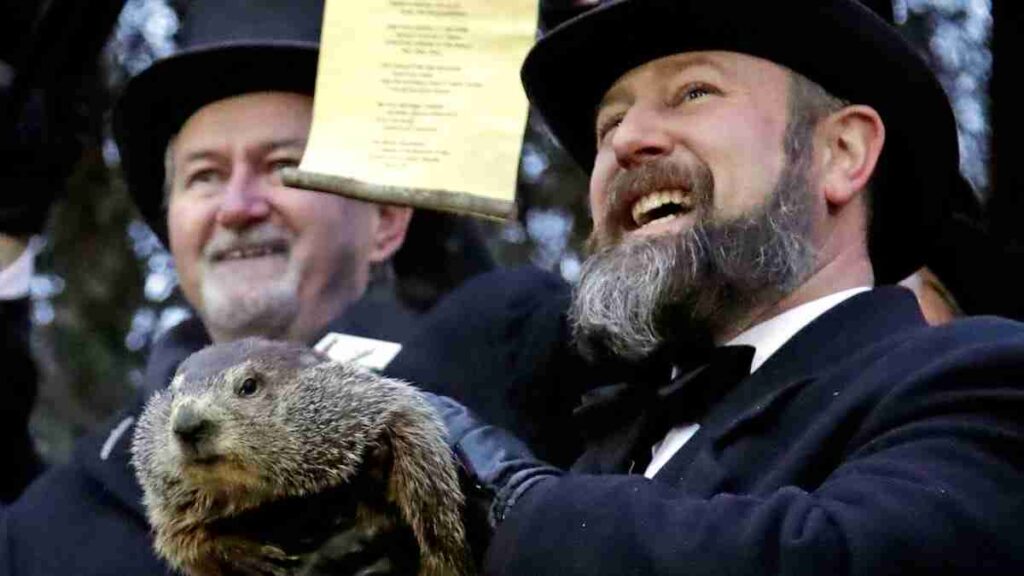
How accurate are groundhog day predictions: Winter will last for another six weeks. Punxsutawney Phil made the forecast after emerging from his hole in Pennsylvania to do his Groundhog Day responsibilities on Wednesday. Thousands of people gathered at Gobbler’s Knob as Punxsutawney Phil predicted the end of the world. Phil was summoned from his tree stump at dawn by his “inner circle” to check whether he’d spotted his shadow. Apart from the fact that this animal foretells the coming of winter, most people would not believe him. Let me lead you through all your groundhog questions to make it more interesting.
- What is the groundhog prediction?
- What is believing in groundhog day called?
- Why does winter last six more weeks if the groundhog sees his shadow?
- How accurate are Groundhog Day predictions?
- Why is Groundhog Day famous?
- Did people ever actually believe groundhogs could predict the weather? Why?
What is the groundhog prediction?
Groundhog Day is an annual celebration in the United States and Canada on February 2nd. The custom is based on Pennsylvania Dutch superstition and folklore. If the groundhog sees his shadow, he will withdraw to his lair, prolonging winter for another six weeks. Spring will arrive early if this is not the case. Pennsylvania hosts the national event.
Also read,
What is believing in groundhog day called?
Groundhog Day is an annual Silly Fun look at superstitions when a sloth-like mammal with zero effect, zero existence, and zero symbolic feelings “predicts” the spring equinox in 6 weeks by either shadow or no-shadow reaction. HOT DAMN! Like tossing a coin with Abraham Lincoln’s stoic profile on both sides, the prediction is the same response either way.
For luck! NAH! It’s for ironic sarcasm, not for irony! As a wide-eyed kindergartener, it taught me that grown-up life would throw crazy stuff at you, and you must think about what is being said about fairies, Santa, the Easter Bunny, and even religion.
The 6 weeks wait for the arrival of The equinox tells us that warmer weather is on the way (but a blizzard may still happen in one or 70 days, or so). The approach of Equinox prevents you from making any firm plans. Planting seeds may or may not result in frozen or dead seed shoots, and you may or may not be hungry next winter.
Equinox in six weeks informs you nothing about what will happen in six weeks, much like a star, palm, tea leaf, and chicken bone readings… just less spectacular. Based on the statistics of brides and grooms puking at numerous banquets, a dropped drop of communion wine, or a wedding toast bringing supernatural retribution is still nonsense!
WOMEN, ON THE OTHER HAND, MAY ASK IF I ENJOY DANCING AND KNOW HOW TO DO SO. My confident response, “I can dance the notorious Caucasian Engineer’s svelt movements,” expresses my total belief that I am fantastic in bed.
Why does winter last six more weeks if the groundhog sees his shadow?
Groundhog Day is merely a fun way to mark the halfway point of the year. Someone with more ambition than I might be able to confirm that it is exactly in the middle.
As a result, Spring is always (approximately) six weeks away on February 2nd. So there will be six more weeks of Winter when the little bugger sees his shadow. Even if you are younger than me, my old friends will tell you that time flies.
In any case, we’re getting near to Spring on February 2nd. Take a minute to enjoy yourself and look forward to the next yearly event, the first day of Spring!
Also read,
How accurate are Groundhog Day predictions?

According to mythology, if Punxsutawney Phil sees his shadow on February 2nd, he will have six more weeks of winter weather ahead of him; no shadow means an early spring. For more than 120 years, Phil, a groundhog, has predicted the weather on Groundhog Day, but how good is he at it?
It turns out, not very much.
Punxsutawney Phil was given the responsibility of predicting the spring weather for the first time in 1887, and the method hasn’t altered much since then. The Punxsutawney Groundhog Club in Punxsutawney keeps an eye out for Phil all year and rouses him before daybreak on February 2 to see if he casts a shadow. (Contrary to common perception, Phil does not need to see his shadow to make his wintery prophecy; all he needs to do is cast one.)
According to the Groundhog Club’s archives, Punxsutawney Phil has predicted 103 more winters and 19 early springs in his many incarnations (including this year). (There are nine years with no records, and the Punxsutawney Area Chamber of Commerce, which keeps track of these things, has no idea what happened to Phil during that time.) Phil’s six-week predictions have been true around 39% of the time, according to statistics from the Stormfax Almanac.
Phil performs somewhat worse when compared to real weather outcomes after 1969, when the veracity of weather records was less questioned, according to Tim Roche, a meteorologist at Weather Underground. Phil’s total accuracy percentage declines to around 36% after 1969.
When the groundhog doesn’t see his shadow, though, his prognostication abilities are significantly improved. “Phil was considerably more likely to be accurate when he anticipated a brief winter,” Roche told Live Science. “He got it right seven times out of 15 times he didn’t see his shadow and predicted an early spring, giving him a 47% accuracy rate.”
And how does this compare to human forecasters? “If Phil is correct 39% of the time, that’s far worse than a climatological forecast. Even if you flip a coin, you’ll be close to half the time correct. This equates to a 50% accuracy rate. So, rather than relying on the groundhog’s forecasts, you should flip a coin.”
Ouch. We examined Phil’s performance with David Unger, a meteorologist with the National Weather Service, to rule out the notion that Roche has a thing against groundhogs. Phil doesn’t appear to be getting a position at the NWS any time soon, either.
In 2011, Unger told Live Science, “It’s incredibly difficult to offer an assessment of how accurate climate predictions are.” “However, when compared to the parameters on which Groundhog Day predictions are made, which are whether the weather will be mild or not mild, we consider our forecasts to be a solid estimate if they are approximately 60% correct or higher.”
So there you have it. According to the statistics, based on Punxsutawney Phil’s prediction, you shouldn’t put away your snow gear just yet. But then, what did you expect? After all, Phil is a groundhog.
Why is Groundhog Day famous?
I’m going to presume that when the OP says “famous,” he means “popular.”
The lunar or agrarian calendar is the basis for the majority of the traditional festivals we observe or recognize. People could determine the longest and shortest days of the year by looking at the moon and stars. People began to utilize the longest and shortest days as marks or grounds for celebration once they could correctly pinpoint when they occurred. When the invaders sought to convert the people to Christianity (read: “force the Pope’s religion on the masses”), they simply appropriated the pagan or druidic ceremony of Solstice or Saturnalia and labeled it a Christian celebration as well.
As a result, what the Pagans called Saturnalia became Christmas. There were other days when it was simple to recognize. The day between the Solstice and the Equinox is known as a Cross Quarter Day. November 1st is the first of four cross-quarter days in a year (regarded as All Saints Day) February 2nd, also known as Groundhog Day, May 1st (considered worthy of celebration by much of the Eastern world as May Day), and August 2nd, the forgotten cross-quarter day. Three of these cross-quarter days have already been designated as causes to rejoice; the rest is up to popular culture to choose if each day is worthy of commemoration.
The simple explanation is that Groundhog Day is ‘popular’ or well-known due to an ancient tradition.
Did people ever actually believe groundhogs could predict the weather? Why?
It is not believed by everyone. At least most don’t. It’s merely a silly tradition or ceremony that serves as an excuse for a festival.
Farmers used to observe the hibernating patterns of various animals to predict the type of season they would have, but it was always a gamble.
Punxsutawney Phil, one of the most famous groundhogs in the United States, is only correct 39% of the time, indicating that he isn’t a good weather predictor.
I hope I cleared your doubt on How accurate are Groundhog Day predictions? Let me know what’s your view on Groundhog Day predictions.
Also read,
Get the latest USA news on Medico topics & its Twitter page
I’m Nawin (Admin), a seasoned doctor and accomplished content writer with 8 years of experience. Join me as I unravel the latest breaking news, unveil behind-the-scenes happenings, and explore the aftermath scenes. With my expertise, I’ve crafted this renowned news site to provide you with an authentic perspective on daily happenings. Get ready to delve into a world of truth and knowledge on Medico Topics.
Coverage: Blogs, Health, Exams, Obituary, Crime
